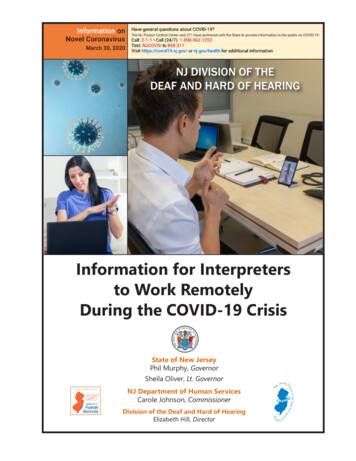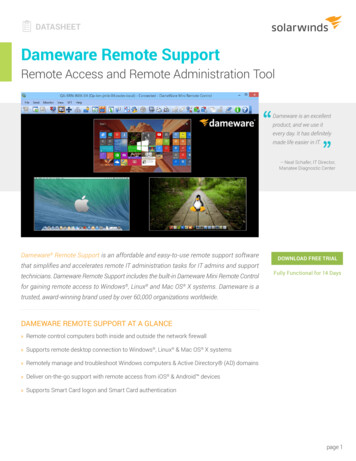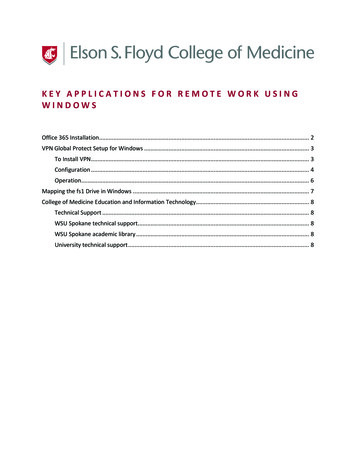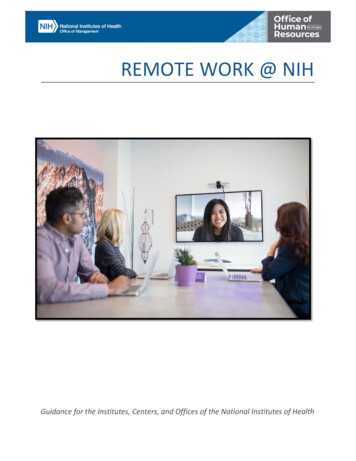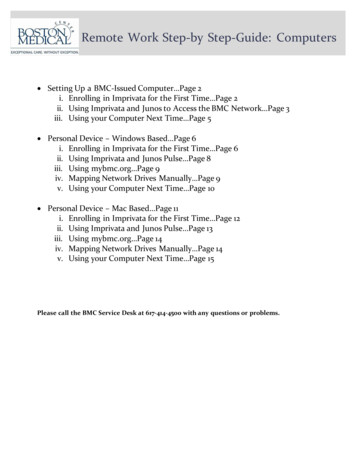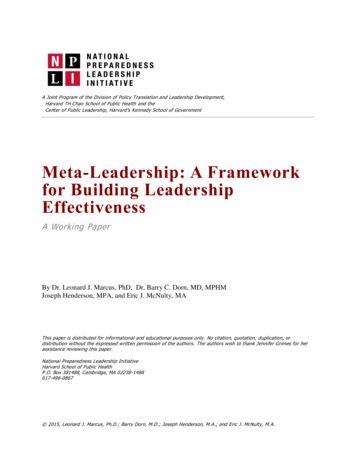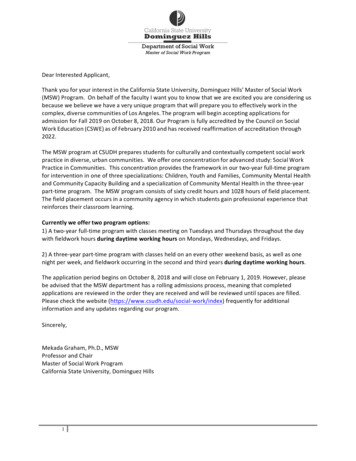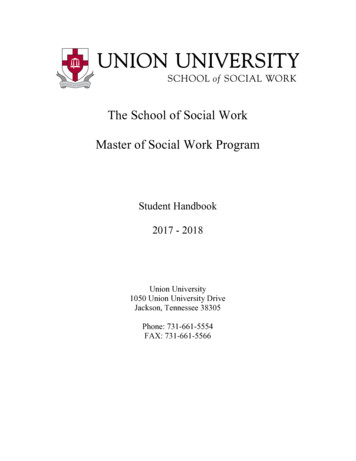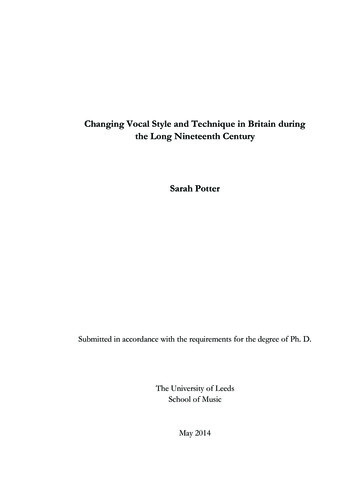
Transcription
Remote work and leadershipduring the Covid-19 Pandemic- An exploratory study on how remote work is affecting leadership styles andemployee motivation.BACHELOR THESIS WITHIN: Business AdministrationNUMBER OF CREDITS: 15HPPROGRAMME OF STUDY: International ManagementAuthor: Emilio Ergovan, Jiabao Guo & Victor SeitlTUTOR: Gershon KumetoJÖNKÖPING May 23, 2021
Bachelor Thesis in Business AdministrationTitle: Remote work and leadership during the Covid-19 PandemicAuthors: Emilio Ergovan, Jiabao Guo & Victor SeitlTutor: Gershon KumetoDate: 2021-05-23Key Terms: The Covid-19 Pandemic; Employee Motivation; Remote Work; DigitalTransformation; Leadership StylesAbstractBackground: The Covid-19 pandemic has impacted all of society, and businesses are facedby having to close or adapt to the new regulations and laws by pursuing digitaltransformation. As companies are transitioning to remote work, leaders are now met with theobstacle of taking in-person, face-to-face leadership and putting it through digitaltransformation. Due to all these unforeseen changes employee motivation is at risk asemployees are working remotely in isolation with leaders adopting new leadership styles.Purpose: This research aims to investigate the change in leadership styles resulting fromremote work and investigate if it has affected employee motivation.Method: This research is an exploratory qualitative study conducted, focusing on multiplecases where semi-structured, and in-depth interviews were held with nine participants fromthree companies, with one leader and two employees from each company. A thematicanalysis was used to investigate the primary data.Conclusion: The empirical findings and the analysis provide two areas that have been foundduring this conducted research:1) Leaders realized that instead of focusing on performances-oriented approaches with heavymonitoring and supervision, it was more important to tend to human-centric care and beingmore open and nurturing to alleviate stress for employees.2) Employee motivation has generally been negatively impacted due to employees andleaders experiencing communication difficulties, loneliness, lack of support and easilyaccessible distractions. With a few exceptions of employees coping better with a morebalanced supervision and higher level of isolation acceptance.
AcknowledgementsFirst and foremost, we would like to acknowledge and extend our gratitude towards our tutor,Gershon Kumeto, for challenging us and providing us with great suggestions and supportthroughout the entire writing process. Thanks to his knowledge and sound advice from dayone, all the way to the finishing line, he has helped and contributed both expertise andvaluable knowledge that have helped us become better researchers and broaden our vision.Without his guidance we would not have the same quality of work that we do today.Furthermore, we would like to thank all participants who took part in our study. Thanks to thetime spent, information and expertise given, we have been able to fully analyze and concludethe effects that the Covid-19 pandemic has had on organizations. Without the participants, theresults of this study would not be where it is today, and we therefore want to thank all ofthem for the time spent assisting us.Last but not least, we would like to thank each other for the tremendous number of hoursspent on this project, as well as the energy and spirit throughout the study. While thesemonths has been stressful, challenging but productive, it has all led to the incredible result weare proud to present today.Emilio ErgovanJiabao GuoVictor SeitlI
Table of ContentsAbstractIAcknowledgementsITable of ContentsII1.0 Introduction11.1 Background11.2 Problem31.4 Research Question41.5 Delimitations41.6 Definitions of Key Terms52.0 Frame of Reference62.1 Literature Review62.1 Digital Transformation62.2 Remote Leadership72.3 Remote Work102.5.1 McGregor’s Theory X and Y132.5.2 Maslow’s Hierarchy of Needs142.5.3 Herzberg's Motivation Hygiene Theory153.0 Methodology3.1 Research Philosophy17173.1.1 Research Paradigm173.1.2 Research Approach183.1.3 Research Design183.2 Method3.2.1 Data Collection18193.2.1.1 Primary data193.2.1.2 Secondary Data193.2.2 Semi-structured Interviews193.2.3 Interview Questions203.2.4 Data Analysis203.3 Ethics213.3.1 Anonymity and Confidentiality213.3.2 Credibility213.3.3 Transferability223.3.4 Confirmability22II
3.4 Case Study4.0 Empirical Findings and Analysis22254.0.1 Interview Overview254.0.2 Interview Themes264.1 Organizational Changes and Implementations264.1.1 Company A264.1.2 Company B274.1.3 Company C274.2 Effects of Remote Work274.2.1 Company A274.2.2 Company B284.2.3 Company C294.3 Leadership Styles294.3.1 Company A294.3.2 Company B304.3.3 Company C304.4 Motivational changes of remote work314.4.1 Company A314.4.2 Company B324.4.3 Company C325.0 Final Analysis346.0 Conclusion377.0 Discussion397.1 Contributions397.2 Practical Implications397.3 Limitations397.4 Future Research408.0 References419.0 Appendices49III
1.0 IntroductionThis chapter aims to provide the reader with an understanding of the chosen topic, theories,and terminology used throughout the research. Additionally, chapter one will introduce thereader to a brief overview of the existing situation that might have resulted in remote workand the need for leadership in a digital context. This chapter concludes with an insight intothe author's delimitations.1.1 BackgroundThe beginning of the 21st century has been an era characterized by new, broader, and boldleadership (Unal, 2016). Technological developments have yielded useful communicationplatforms such as Zoom, Microsoft Teams, and Skype. Moreover, these communicationplatforms have prompted leaders to transition their leadership style to be digitized, as a result,organizations can be more agile, flexible, and responsive (Schmidt, 2014).However, in the wake of the global Covid-19 pandemic, business operations have experienceddisruption to various degrees, and traditional business practices have taken a significant impact(Bartik et al. 2020). Reports from the world bank denote that this pandemic's effect are themost devastating since the great depression in the 1930s (Harris et al. 2020).During the last decade, digital transformation has become an essential factor for organizationsas it became a catalyst for inducing company growth (Sabbagh et al. 2013). Lankshear &Knobel (2008) define digital transformation as adopting digital technology through replacingnon-digital processes to transform services or businesses. The employees' mindset towardsdigital transformation will be determining the impacts it will have on the organization in termsof adoption and the efficiency it will bring (Solberg et al. 2020).With that said, digital transformation has come to get a whole new meaning and importancefor organizations in 2020/2021; it is now a matter of survival or going out of business(Blackburn et al. 2020). As the demand for remote work and social distancing is at an all-timehigh, leaders have been pushed to make changes. Further, it is also of grave importance fororganizations to digitize to fight and minimize the risks of spreading and contracting Covid-19,which has led organizations to adapt and change to make their workplaces digital instead. Astudy made among enterprise leaders in the UK stated that 96% of them had experienced aboost in digital transformation (D'mello, 2020).1
Companies such as Twitter, Google, and Facebook are also encouraging their employees towork from home. Twitter has even opened the door to making this an indefinite option foremployees going forward (Guynn, 2020). As previously stated, many organizations arefollowing these giant companies' footsteps. One can infer that it yields less expenditure as lessoffice space is required and provides employees with more autonomy to conduct their workfrom home.The concept of remote work was initially proposed as early as 1957 under the term "telework."However, the term did not get attention until the 1970s, after the oil crisis (Gallardo & Whitacre,2018). Remote work has been an exciting factor for companies and industries returning to theend of the 1980s (Baruch, 2002). However, today's practices have changed, and today, workingfrom home is becoming more interesting for organizations, freelancers, and employees whowant to have more flexible and self-controlled work (Gallardo, & Whitacre, 2018). Todayworking from home has led to a digital transformation to stay connected and up to date withthe entire organization and its various department (Martins et al. 2004).Thanks to the modernization of technology and software applications, leaders have anabundance of technology at their disposal, Zoom, Microsoft teams, Google hangouts, Skype,and Slack, just to name a few. However, the challenge is that there is limited information,knowledge, and know-how on leading, navigating, and motivating employees through theCovid-19 pandemic, less so in a digital transformation context. Further, this is a challenge asthere is no clear path for what leadership style is right or wrong, nor any past data on itsimplications on employees' work attitudes (Blackburn et al. 2020).Further, in many organizations, leaders lack the knowledge and preparation for such a sudden,devastating event and are grappling with leading an organization in a holistic, performanceefficient direction (Hatami et al. 2020). Moreover, it is a tough spot for leaders to get all theiremployees on the same track, which is of great importance. This is because the collectivemindset and participation towards digital transformation will directly affect growthopportunities and how well it is possible to retain work resources (Solberg et al. 2020).Leaders are also under increased pressure from regulators and guidelines from institutions likethe World Health Organization (from now on referred to as WHO), Ministry of Health (MOH),politicians, and other healthcare experts. According to WHO data, more than 150 millionpeople have been infected by Covid-19, and more than three million have died as of March2021 (WHO, 2021). Anti-pandemic measures such as social distancing and quarantine haveundoubtedly caused severe impacts on many industries that rely on centralized operations.Leaders must step up to show that they can continue leading an organization, despite digitaltransformations. Leaders are now met with the obstacle of taking in-person, face-to-faceleadership and putting it through digital transformation.2
1.2 ProblemThe Covid-19 pandemic has impacted all of society, and businesses are faced by having toclose or adapt to the new regulations and laws by pursuing digital transformation. Ascompanies are transitioning to remote work, the effects on employee attitude and motivationare at risk as daily routines change, in return for less overwatch and more flexibility.According to Bloom et al. (2014) remote work and digital transformation have been of interestfor several years before the Covid-19 pandemic. Organizations that decided to implementdigital transformation as part of their business have reported both positive and negative resultswith a remotely located staff (Bloom et al. 2014).However, as the Covid-19 pandemic emerged as a shock, organizations were forced to quicklyadopt digital transformation throughout the entire organization (Ahmad, 2020).With a remote workplace, leaders have less oversight, and employees are given more freedomand responsibility. There is limited information on how remote work affects the leader'sleadership style employee motivation. There is limited information on how remote work affectsthe leadership style and employee motivation. Furthermore, remote work also became morechallenging to tackle in the beginning, because many organizations were underprepared for anevent such as the Covid-19 pandemic, both in terms of leadership preparation and the usage ofdigital communication platforms. More specifically, both leaders and employees are used toface-to-face interactions in the workplace, as leading an organization remotely (i.e.communicating digitally) is a new phenomenon for many leaders. Further, many organizationshave minimal experience using communication platforms such as Zoom, Microsoft teams,Google hangouts, Skype, Slack, and more that are required to conduct remote work (Blackburnet al. 2020).The existing gaps in knowledge and research about remote work are that the current literaturelacks research on how leadership styles change when moving from face-to-face in a physicaloffice to remote work and, investigating how this has affected employee motivation.This gap is notable and worth filling because it complements the current research on remotework but digs deeper and focuses more on the relationship between leadership style andemployee motivation.1.3 PurposeThis research aims to investigate the change in leadership styles resulting from remote workand investigate if it has affected employee motivation.Authors such as Kanupriya (2020) claim that pandemics and crises similar to the Covid-19pandemic are likely to happen again in the future. Hence, this research is much warranted asthe expansion of world connectivity is happening at a rapid pace. The global impact is immense,and leaders of organizations might gain some valuable insight into how to grapple with a3
similar level of unprecedented disruption in the future. Given the circumstances and regulationsimplemented by governments worldwide, organizations have had to adapt to the enforcedsocial distancing laws, which have forced organizations to find solutions to remain operational(Harris et al. 2020).The Covid-19 pandemic has led to a significant number of organizations to reorganize anddevelop digital transformation, the report will also provide knowledge and understanding ofwhat effects remote work has on employee's motivation and leadership styles. These effectsare necessary knowledge, given the recent global developments where the Covid-19 pandemichas acted as a catalyst and expedited digital transformation, and pushed organizations tomigrate towards remote work faster (D'mello, 2020; Delwer & Boe, 2020).1.4 Research QuestionThe research questions outlined will form the foundation of this study, and the followinganalysis aims to fulfill the purpose of the paper. Hence, the research questions are:RQ I: How has leadership changed from the transition of face-to-face to digital interaction?RQ II: How has remote work effected employee’s motivation?1.5 DelimitationsThe focus of this research aims to look at leadership styles and employee’s motivation. In orderto gain a broader understanding of the topic examined, our research will also include theoriesand models that consider the aspect of different leadership styles. This study will be intendedfor a leadership and employee perspective.The scope of the research is on organizations that have gone through the process oftransitioning their work from an office setting to working remotely. This research is not focusedon investigating organizations that have gone through extensive digital transformation beforethe pandemic rather than during it. The rationale for this is that the research is focused onunderprepared organizations, where leaders had limited experience of leading organizationsconducting remote work and what lessons can be learned from an unexpected digitaltransformation process.4
1.6 Definitions of Key TermsLeadership – Leadership is a process of social influence which maximizes efforts of otherstowards the achievement of a goal.Remote work – The practice of an employee working at their home, or in some other place thatis not an organization's usual place of business.Remote leadership - the process of social influence, which maximizes efforts, encouragement,and motivation of people working from a location that removes physical interaction.Digital Interactions – A digital activity to build an interaction between an individual and anorganization that is possible only because of digital technologies. This tool eliminates theneed for face-to-face interactions.Digital Transformation – The adoption of digital technology to transform services or businesses,through replacing non-digital or manual processes with digital processes or replacing olderdigital technology with newer digital technology.Face-to-face conversation– Physical interaction, includes office meetings, conversations andother form of verbal conversations taking place in an office.Human-centric care – A focus on kindness, compassionate, sympathetic, or generous behavioror disposition, from one human to another.5
2.0 Frame of ReferenceChapter two aims to provide the theoretical background to the research topic in terms ofliterature by outlining the models, and theories used throughout the study. Secondly, it willpresent the theory for the following sections that are considered as key factors: Covid-19Pandemic, Digital Transformation, Leadership Styles, and Remote Work.2.1 Literature ReviewThroughout the research, we will acquire reputable and pertinent sources that relate to andsupport our purpose. The literature has been collected through prior academic work, includingprevious research, theories, and studies that have been collected from Google Scholar,Jönköping University Library and Northumbria University Library with their literature searchengine Primo. A qualitative research approach is warranted for this research as it allows theauthors to draw comparisons between primary and secondary data. Further, one can get a betterimpression of specific patterns, which would help make conclusions. Lastly, it will allow theauthors to better understand the critical role context plays, and how it might affect the results.Table 1: The table presents the criteria and process of the report’s literature review.Literature ReviewDatabasesGoogle Scholar; Jönköping University Library ServicesPrimo; Northumbria University Library Services PrimoMain Theoretical FieldsSearch WordsLeadership Styles, Remote Work, Digital TransformationLeadership Style Covid-19, Leadership Styles, Effects ofRemote Work, Digital Transformation, Remote WorkCovid-19Academical Articles, Thesis, Studies & BooksSearch words has been made with the compromise ofkeywords mentioned in the abstracts, definitions andother related terms within the area.Literature ReviewCriteria for Article Selection2.1 Digital TransformationSolberg et al. (2020) explain the rare end of digital transformation, which is the synergybetween the people within the organization and technological change. More specifically, theresearch depicts and explores the digital mindset of employees and what impact that can havefor both recognizing and leveraging beliefs for digital transformation. Solberg et al. (2020)explain that this is important because employees' beliefs about technological change are pivotalas they directly affect the engagement with an organization's digital transformation initiatives.Employees' mindset and digital mindsets shape how these transformations can provideopportunities for professional growth and retain work resources.6
Johnson et al. (2008) investigates the importance of reinventing yourself and your operationsas a company to; firstly, not becoming stagnant and secondly, to address changes to the externalbusiness environment. The study was conducted by looking at big companies and investigatingthe importance of transforming to survive, maintain or improve their position in the market.Big companies such as Wal-Mart and Target shifted their business models to stay competitiveand pioneered the retail market (Johnson et al. 2008). In order to survive as the external marketconditions started to change with the popularity of internet retailers, Wal-Mart decided toinitiate digital transformation to diversify and make its shopping available online. The strategywas a strategic digital transformation shift that made Wal-Mart diversify and leverage itstechnology to remain competitive. Competitors such as Kmart failed to do the same and, as aresult, went from being one of the biggest department stores in America to virtually becomenonexistent. By staying vigilant to changes in the market trends, being flexible and proactive,Wal-Mart still manages to stay alive even today and compete with giant internet retailers suchas Amazon. Johnson et al. (2008) conclude that many companies should take notice of whatcompanies such as Wal-Mart have done in order to survive (Johnson et al. 2008).Similarly, Bleicher & Stanley (2019) suggest that digital transformation approaches can makeor break an organization. When a business venture manages to exploit digital transformation,it can lead to sustainable economic accomplishment, but failing to do so can be devastating foran organization. Bleicher & Stanley (2019) explain that digital transformation can act as acatalyst for an organization as it provides opportunities for connectivity, enhanced decisionmaking, increased productivity, and economic growth.2.2 Remote LeadershipA study of French and international employees' examined behaviors in remote leadership thatwould have a high-quality impact on the relationship between employees and their leaders(Jawadi, et al. 2013). In order to determine what behavior was the most impactful in terms ofquality, the study focused on several role behaviors. These behaviors were: broker, director,producer, mentor, innovator, and facilitator. Jawadi et al. (2013) concluded that the differentroles had various levels of impact, but the social roles of being a facilitator and mentor had thehighest quality impact on employee-leader relationships. Further, the study also showed thatthe leaders in open system roles, roles of rational pursuit of goals, and human relation rolesalso had a notable positive impact on the relationship between employees and leaders (Jawadiet al. 2013).Kerrissey & Edmondson (2020) write about what makes for good leadership during a globalpandemic. The authors look at two separate leaders, Adam Silver, the commissioner of theNational basketball association (NBA), and New Zealand Prime Minister Jacinda Ardern. NBAcommissioner Adam Silver decided to suspend the basketball season and was one of the earliesthigh-profile leaders to take decisive actions as a response to Covid-19. Jacinda Ardern was alsoearly and delivered a nation address where she announced a four-level Covid-19 alert system.Thanks to the quick decisions and implementations of guidelines, regulations were introducedand presented their expectations on the country's citizens. Kerrisey & Edmondson (2020)7
suggested that unique and bold leadership as displayed by both Silver and Ardern is criticalwhen pushing against natural humans' tendencies of downplaying and delaying. The authorsboil down the information into four pillars for every leader to learn after. The first is to act withurgency, which entails that leaders make urgent decisions without all the information. This ischallenging as the risks of delaying decisions usually are inevitable, much like the cases forboth Silver and Arden. Secondly, is to communicate with transparency – express an honest andaccurate description of the current circumstances. Thirdly, is to respond productively toeventual missteps. Problems will come up for all leaders, and it is vital to know how to dealwith them. It is crucial for leaders to quickly reassess, listen, acknowledge and orient everyonethey lead toward solving the problem. Lastly, Kerrissey & Edmondson (2020) conclude that itis vital for leaders to engage in constant updating. Leaders are required to be steady and usestrategies to elicit new information and stay on top of the situation and keep everybody in theloop as new information comes to light. Relying on advisors and outside opinions can beincredibly valuable tools, which was proved to be valid for Silver, who had a long list ofmedical advisors. Similarly, Ardern was also aided by medical and virologist experts whenmaking decisions (Kerrisey & Edmondson, 2020).Holmberg & Petrelius (2020) conducted a study on 34 different managers to investigate howtheir leadership styles have been affected by the Covid-19 pandemic. The authors explain thatmany managers experienced struggles, both with their roles and their view of leadership.Finding the balance between encouraging independence and self-motivation while havinginsufficient capabilities of live monitoring the workers was a common challenge amongst mostof the interviewees. Holmberg & Petrelius (2020) indicated that building and sustaining trustbecame increasingly difficult, especially as work transitioned from physical offices to remoteworkplaces. As physical contact and overall oversight of the business operations diminisheddue to remote work, managers had to trust their employees and implement new practices. Asmany managers became unsure of themselves, the authors conclude that communication andtrust (trust the process of change, trust in the employees, and for the leaders to trust him/herself)are the central factors for leaders in an organization during this pandemic (Holmberg &Petrelius, 2020).Similarly, with Holmberg & Petrelius's study, Sobel Lojeski and Reilly (2020) suggest tacitcommunication is hard to convey in a virtual setting. Further, many smaller, informal socialinteractions such as "Water cooler conversations" or talking in the kitchen or break room werealso found to be a common loss among the managers. This is crucial as many previous studiessuggest that critical decision-making, lobbying, and dialogues are born through the informalchit-chat and small talk that might transpire throughout a traditional, physical workday(Malhotra et al. 2007). Conclusively, the authors suggest that Covid-19 has warranted arestructuring of the work, and with moving more towards remote work, new leadershippractices can develop primarily collective leadership. However, there is a decent gap that canbe filled further on how managers can improve and highlight a more holistic view of whatremote leadership entails (Holmberg & Petrelius, 2020).8
Wakefield et al. (2008) conducted a study on leadership behavior in a textual social cue, i.e.,nonverbal communication. The study's focus was to investigate the roles that leaders fill in theteams they lead. It was conducted on American employees who were part of a team and fiveKorean companies. The study showed that leaders who demonstrated consistent qualities withmonitoring, facilitating, mentoring, and coordinating experienced that the number of conflictsin the team was reduced and the team's overall effectiveness increased (Wakefield et al., 2008).The notion of leaders displaying qualities of mentoring and coordinating to improve teamperformance is further supported in another study conducted by Sutanto et al. (2011). Thisstudy focused on undergraduate students working with problem-solving tasks. In order toanalyze the result, the researchers analyzed the social network interactions occurring betweenthe students. The results indicated that leaders that were less prone to monitor his/her groupextensively and try to be more of a mediator rather than director, saw better effectiveness thangroups with leaders that displayed authoritarian behaviors characterized by lots of scrutiny’s(Sutanto et al. 2011).In the article "Virtual Leadership: An important Leadership Context," Schmidt (2014) proposedthe transformation trend of the leadership styles in the information age. The article emphasizesthe improvement of the efficiency of leaders under different leadership styles and themaximization of the overall organizational productivity. The potential drawbacks of remotework require leaders to apply innovative communication methods to strengthen thetransmission of information within the organization (Gajendran & Joshi, 2012) and personalcommunication between employees. Although traditional face-to-face communication isdifficult to achieve through remote work, the options of multiple media methods such as email,online meetings, and team collaboration platforms are also affecting the transmission ofinformation in today's organizations. In Lord and Dinh's (2014), research, it was concluded thatcompared with traditional leadership methods that focus on reviewing the history and assessingleadership performance, organizations and leaders who use remote work could make moreflexible plans for future information and changeable models with the help of technologicaladvances.As work moves from the physical office, leaders and employees have to adapt and collaborateto make a smooth transition of the workplaces (Barrios & Pitt, 2020; Antonacopoulou &Georgiadou, 2020). Their conducted study successfully identified how leaders could help andassist their employees once they moved from the physical office to remote workplaces. Firstly,leaders have to improve communication to have more precise communication (Barrios & Pitt,2020; Smartsheet: Majority of Young Workers, 2020) in what tasks are the most important andbecome better in delegating the work necessary for the team to perform. As employees arespread around, communication is vital in order to have all employees on the same page. Barrios& Pitt (2020) also identified the necessity for leaders to be available for the employees. Aleader in a remote working environment has to be available for all employees for work and talkabout issues with the remote working environment. As employees feel less involved in thebusiness (Smartsheet: Majority of Young Workers, 2020), leaders should get more involvedwith their employees to make sure stress levels and anxious feelings decrease (Barrios & Pitt,2020). Leaders have to understand the importance of physical contact that was a common factor9
before, but which has now become difficult due to regulations. If leaders fail to face that factorand find a solution in the form of c
Transformation; Leadership Styles Abstract Background: The Covid-19 pandemic has impacted all of society, and businesses are faced by having to close or adapt to the new regulations and laws by pursuing digital transformation. As companies are t
